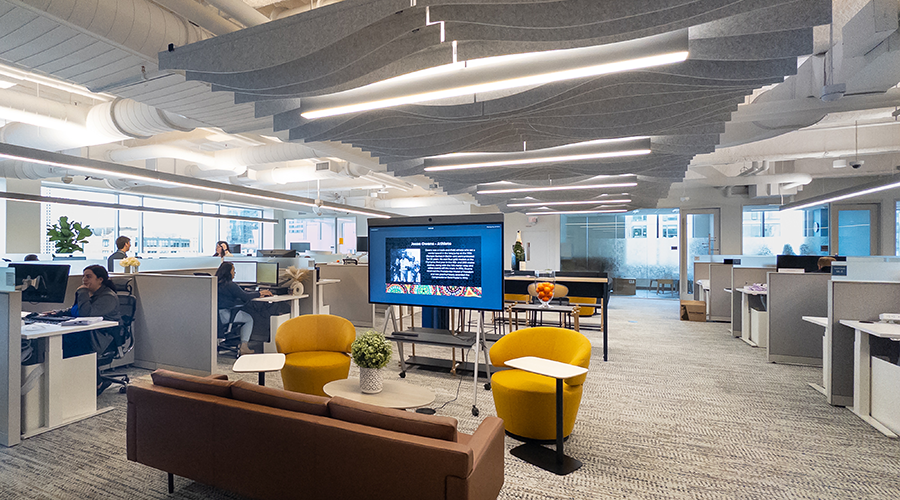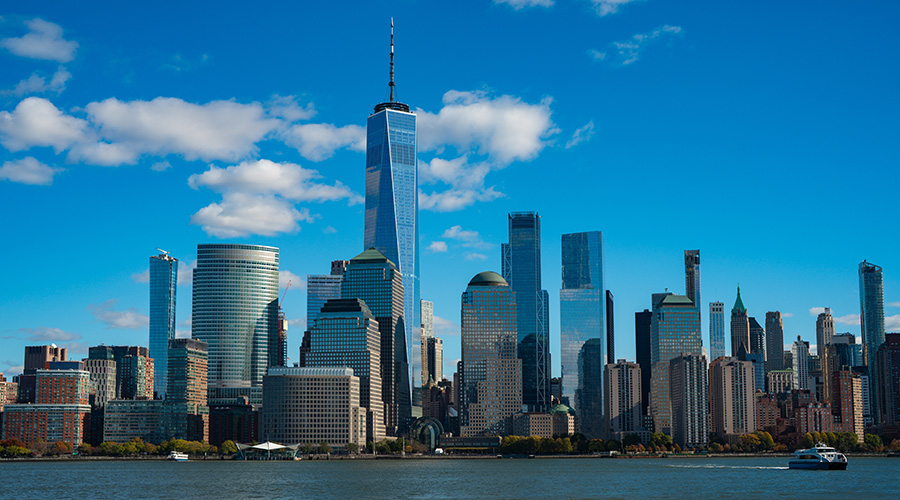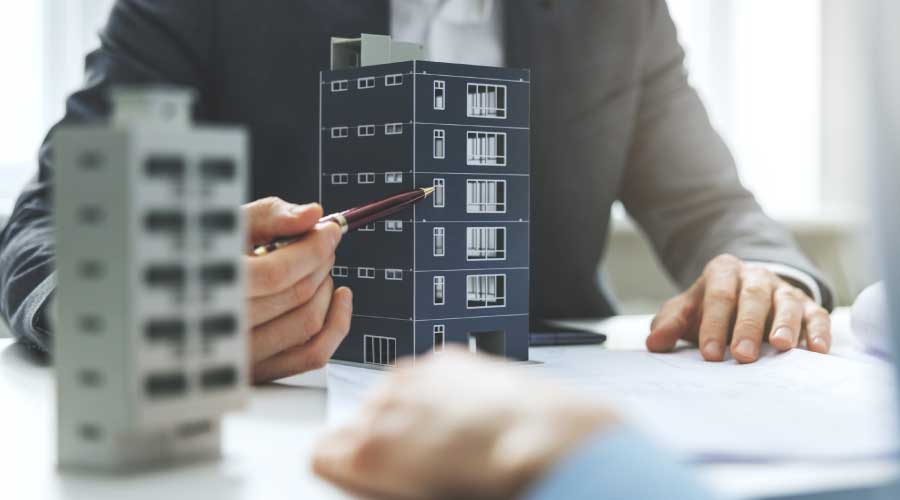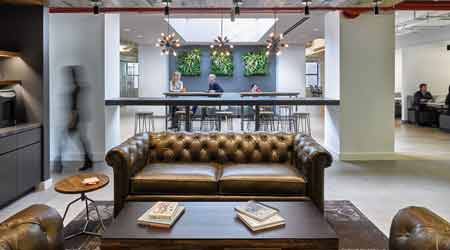 Plants installed vertically on the wall as living art provide an interesting focal point while bringing nature indoors. The objective is to provide workers a bit of relief from metal and psychological fatigue.Garrett Rowland/courtesy HGA
Plants installed vertically on the wall as living art provide an interesting focal point while bringing nature indoors. The objective is to provide workers a bit of relief from metal and psychological fatigue.Garrett Rowland/courtesy HGAHow Nature and Culture Enhance Happiness, Wellness, Productivity in Office Space
Including both outdoor spaces and natural elements indoors, as well as space that communicates a corporate brand and culture, is key to occupant satisfaction, wellness, and worker retention.
In 21st century workplaces, incorporating nature and natural elements isn’t a choice; it’s a necessity. With office workers spending so much time indoors, the benefits of bringing more natural elements into the workplace to inspire comfort, productivity, wellness, and creativity are paramount.
This strategy works on several different levels. First, décor: Reclaimed wood panel installations, water features, exposed concrete flooring, and living walls of greenery are being integrated into workplace design. At Criteo, living plants were inserted into a breakroom wall to provide workers’ relief from mental and physiological fatigue. It not only serves the need for a natural element but also provides screening between the break area and the open office area.
Second, biophilic principles are finding their way into workplace design. These biophilic strategies being incorporated into workplace environments include wallcoverings (or wall graphics), fabrics, and artwork featuring patterns derived from nature — such as veining in leaves or the molecular geometry of minerals.
Third, today’s employees want outdoor space as part of the workplace. Ensuring access to the outdoors means designing rooftop gardens, as at Criteo, or extending the workplace by creating outdoor meeting rooms.
As well, because strategies that support employee wellness became integral to workplace design, adjustable-height workstations, desks, and tables have become a must. Each employee’s ability to easily change the height of their workstation — and thus their posture — throughout the day has had a positive effect on productivity and health.
A recent innovation in this area is a stool-like chair on which employees can perch (not sit) — or rest while leaning — as they work. This postural position between sitting and standing provides another level of support that employees are welcoming. Often concurrent with adjustable workstations is the issue of mobility. At Guidewire Software, a group of engineers requested mobile (and adjustable) workstations. The challenge: How to keep technological devices plugged-in and charged-up while employees and workstations moved around the room? The solution was to install power posts or towers every six feet, with electrical and telephone/data plugs, so the engineers could plug and play while in extremely mobile groups.
Branding beyond the logo
Communicating a company and workplace culture through design is essential. Logo size, color, and shape reinforce the company’s values and culture. Some companies are subtle about how their brand is portrayed; others are bolder. Before designers put pen to paper and begin design, they should meet with a broad cross-section of company employees to learn what, for them, creates the perfect working environment and how exactly that physically translates into what they believe is their company culture.
Ooyala, which means “cradle” in Telugu according to the company, was clear: No in-your-face logo for their walls. Instead, an expanded cradle concept, which is reflected in the circles of the company’s logo, is exemplified in round conference rooms, a 25-foot collaboration tunnel (inspired by a video camera’s zoom lens) that connects the entire office, and circular seating elements and cubbies built into a wall adjacent to a conference room.
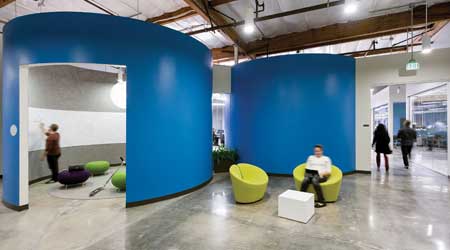
(At Ooyala, which means “cradle,” two round conference rooms echo the brand’s concept by evoking cocoons. The colorful ottomans also mimic the company’s logo, subtly reinforcing branding. Photo Gregory Cortez/courtesy HGA.)
In other words, branding today — particularly in the high-tech world — is no longer simply about the design and implementation of a logo. Instead, nuanced elements of the logo find their way into the entire workplace design. In this way, branding creates a unique visitor experience, a singular work culture that gives employees a sense of identity and connection, and a sense of cultural support that reinforces employees’ investment in the company and their work.
At Ooyala, the two blue, round conference rooms, in particular, suggest structures within a structure, again conveying the notion of a cradle or cocoon in which to find inspiration and brainstorm. The colorful circles of Ooyala’s logo also materialize in office and meeting areas to brighten up the spaces.
At Criteo, shapes abstracted from the logo were inserted into architectural elements like the reception desk and used as ceiling elements. In this way, branding is subtle, becomes an integral part of workplace design, and relates to the ethos of the company.
The design of workplaces continues to evolve, in order to address the ways in which new generations of workers utilizing ever-evolving technologies can maximize their productivity, work processes, and well-being. Imagination and creativity are just as essential to generating these innovative designs as the employee input that drives the design innovations — input that’s crucial to understanding just what makes employees today healthy, happy, and willing to invest in their company culture. In the field of workplace design, creating environments that accomplish all of these goals is of the upmost importance and continues to inspire designers to pioneer and introduce new solutions.
Lisa Macaluso, CID, LEED-AP, IIDA, is associate vice president, HGA Architects and Engineers. HGA has created workplace designs incorporating principles described in this article for clients such as Ooyala, Criteo, and Guidewire Software. She can be reached at LMacaluso@hga.com.
Email comments to edward.sullivan@tradepress.com.
Related Topics:













